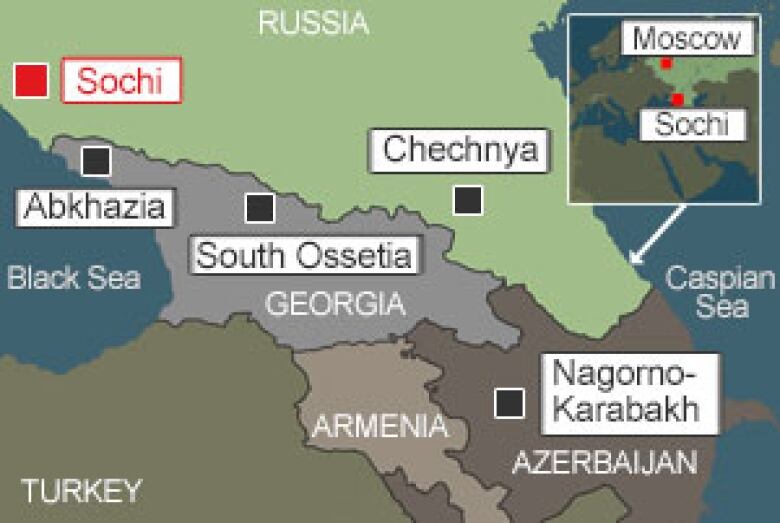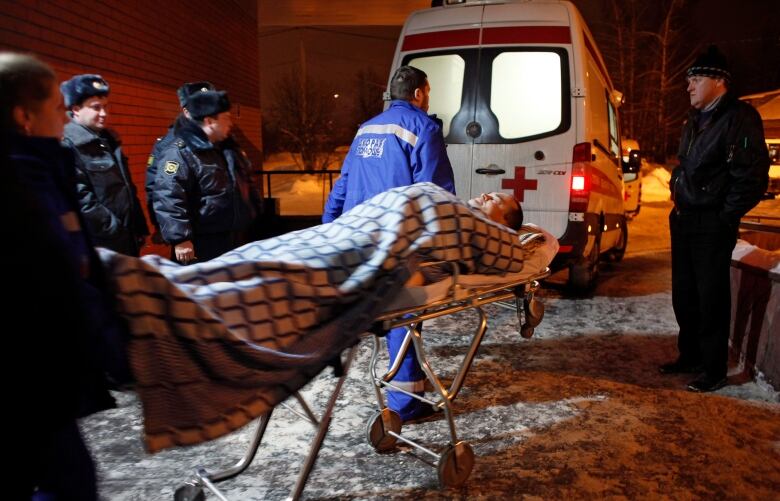Russia's Caucasus: A history of unrest
Although there has been no claim of responsibility forthe two bombings in Volgograd that killed at least 31 people in lessthan 24 hours, suspicion quickly fell on Caucasus rebels who havetormented Russia with attacks for nearly two decades.
The insurgency has its roots in wars fought between separatistChechen rebels and Russian forces, but it has spread throughout theNorth Caucasus region, which includes several mostly Muslimrepublics.
- Have the bombings in Russia changed your SochiOlympic plans?
- The Passionate Eye: Putin's Games
- Russia's Sochi Olympics awakens Circassian anger
Most assaults have been within the Caucasus, but attackers haveoccasionally reached far outside the region, including Moscow.
Volgograd, which borders the North Caucasus region to the north and is a hub by which people can get to 2014 Olympic host city Sochi, wasearlier hit by an insurgent suicide bombing that killed six peoplein October.
And earlier this year, the suspects in the Boston Marathon bombings wereidentified by law enforcement officials and family members as Dzhokhar and Tamerlan Tsarnaev, ethnic Chechens with ties to the Russian region. There was no immediate information of their links, if any, to any insurgent group.
Before moving to the United States, Dzhokhar Tsarnaev lived briefly in Makhachkala, the capital of Dagestan, a predominantly Muslim republic that has become the epicentreof the Islamic insurgency that spilled over from Chechnya. On his page on the social networking site VKontakte, Tsarnaev said he attended School No. 1 from 1999 until 2001.
The principal of School No. 1 in Makhachkala, Irina Bandurina, told the AP that Tsarnaev left for the U.S. in March 2002.
Chechen conflict
The conflict in Chechnya began in 1994 as a separatist war, but quickly morphed into an Islamic insurgency dedicated to carving out an independent Islamic state in the Caucasus.
Russian troops withdrew from Chechnya in 1996 after the first Chechen war, leaving it de-facto independent and largely lawless, but then rolled back three years later following apartment building explosions in Moscow and other cities blamed on the rebels.
- Boston bombing suspects' family split on guilt, innocence
- Margaret Evans: Grozny's makeover can't mask Chechen menace
Chechnya has stabilized under the steely grip of Kremlin-backed local strongman Ramzan Kadyrov, a former rebel whose forces have been accused of massive rights abuses.
But the Islamic insurgency has spread to neighbouring provinces, with Dagestan, sandwiched between Chechnya and the Caspian Sea, becoming the epicentreof violence with militants launching daily attacks against police and other authorities.

Militants from Chechnya and neighbouring provinces have carried out a long series of attacks in Russia, including a 2002 hostage-taking raid in a Moscow theatre, in which 129 hostages died, a 2004 hostage-taking in a school in the southern city of Beslan that killed more than 330 people, and numerous bombings in Moscow and other cities.
The Obama administration placed Chechen warlord Doku Umarov on a list of terrorist leaders after he claimed responsibility for March 2010 double suicide bombings on Moscow's subway that killed 40 and a November 2009 train bombing that claimed 26 lives.
A suicide bomber killed 37 people in January 2011at Moscow's Domodedovo Airport, the country's busiest.
In recent years, however, militants in Chechnya, Dagestan and other neighbouring provinces have largely refrained from attacks outside the Caucasus.
International links
Russian officials and experts have claimed that rebels in Chechnya had close links with al-Qaeda. They said that dozens of fighters from Arab countries trickled into Chechnya during the fighting there, while some Chechen militants have gone to fight in Afghanistan.
The U.S. has long urged Russia's government and separatist elements in Chechnya not aligned with al-Qaeda or other terrorist organizations to seek a political settlement.
Washington provided aid to the area during the high points of fighting in the 1990s and in the early 2000s, and has demanded human rights accountability.
But the U.S. always backed the territorial integrity of Russia, never endorsing the separatists' desire for an independent state. And it has supported Russia's right to root out terrorism in the region.
As the insurgency expanded its operations, concentrating onDagestan as the second Chechen war subsided, it became known as theCaucasus Emirate movement. Since 2007, its leader has been Umarov, formerly the president of the self-proclaimed separatistChechen Republic of Ichkeria.

The command structure is unclear. With adherents scattered acrossa large area, much of its activity may be directed by local warlordswhose influence is limited to a particular district, some analystssay.
In 2010, as concern about the rebellion grew in the run-up to theSochi Olympics, Russia created a new administrative districtencompassing the Caucasus republics to try to co-ordinate efforts towipe out the insurgency. The district's centre is the city ofPyatigorsk, where a car bombing near a police station killed threepeople on Friday.
After theDomodedovobombing,Umarovdeclared an end to attackson civilians, but reversed that order in July, urging his men to"do their utmost to derail" theSochiOlympics, which he describedas "satanic dances on the bones of our ancestors."
Charges in Europe
In recent years, people from Chechnya have faced charges in several European countries.
In 2011, a Chechen-born man was sentenced in Denmark to 12 years in prison for preparing a letter bomb that exploded as he was assembling it in a Copenhagen hotel a year earlier.
Lors Doukayev, a then 25-year-old, one-legged resident of Belgium, was wounded when assembling the device, which is believed also to have been intended for the Jyllands-Posten newspaper, which published controversial cartoons of the Prophet Muhammad. No one else was injured. The letter was filled with steel pellets and contained triacetone triperoxide, or TATP, which terrorists used in the bombs that killed 52 people in London in 2005.
Last month, Spain's Interior Ministry said French and Spanish police arrested three suspected Islamic extremists in an operation in and around Paris. A statement said the suspected activists were of Chechen origin and believed to be linked to an alleged terror cell dismantled last August in southern Spain. The cell was suspected of planning attacks in Spain and elsewhere in Europe.
Two suspects, Elsy Issakov and Mourad Idrissov, were arrested in Paris and a third, Ali Dokaev, was detained in the town of Noyon, northeast of the French capital. The arrests took place Feb. 26.
In August, two Russians arrested in the southwestern Spanish city of La Linea were charged with belonging to an unnamed terror organization and possession of explosives.













_(720p).jpg)


 OFFICIAL HD MUSIC VIDEO.jpg)
.jpg)



























































































